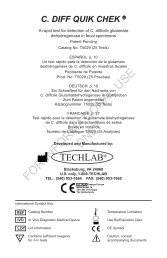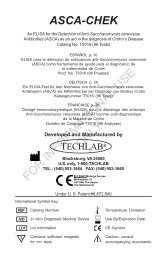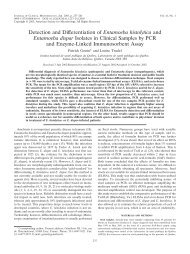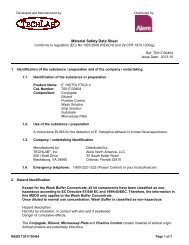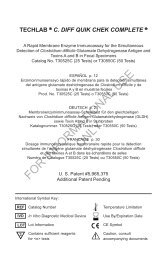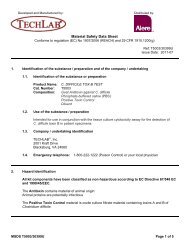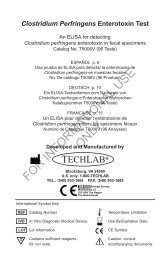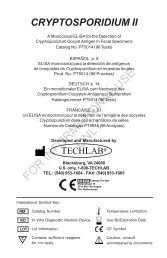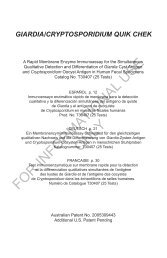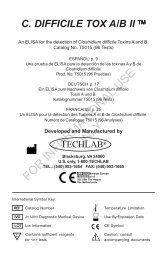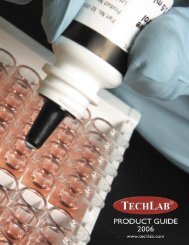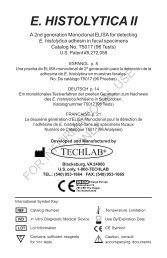Wampole C. DIFF QUIK CHEK COMPLETE 11-2011.pmd - TechLab
Wampole C. DIFF QUIK CHEK COMPLETE 11-2011.pmd - TechLab
Wampole C. DIFF QUIK CHEK COMPLETE 11-2011.pmd - TechLab
You also want an ePaper? Increase the reach of your titles
YUMPU automatically turns print PDFs into web optimized ePapers that Google loves.
3blue line on the “Tox” side of the Reaction Window. A blue line indicates a positive test.A positive “C” reaction, indicated by a vertical dotted blue line under the “C” portion ofthe Reaction Window, confirms that the test is working properly and the results are valid.MATERIALS PROVIDEDMEMDILDEVSPEMembrane Devices – each pouch contains 1 deviceDiluent (22 mL per bottle) – Buffered protein solution with graduateddropper assemblyWASH REAG Wash Buffer (12 mL per bottle) – Buffered solution with graduated dropperassemblySUBS REAG Substrate (3.5 mL per bottle) – Solution containing tetramethylbenzidineCONJ ENZ Conjugate (2.5 mL per bottle) – Mouse monoclonal antibody specific forglutamate dehydrogenase coupled to horseradish peroxidase and goatpolyclonal antibodies specific for toxins A and B coupled to horseradishperoxidase in a buffered protein solutionCONTROL + Positive Control (2 mL) – Antigen in a buffered protein solutionDisposable plastic transfer pipettes – graduated at 25 μL, 400 μL and 500 μLMATERIALS AND EQUIPMENT REQUIRED BUT NOT PROVIDEDSmall test tubes (e.g., plastic Eppendorf tubes or glass tubes)Applicator sticks Timer Vortex mixerDisposable gloves for handling fecal samplesPipettor and tipsSHELF LIFE AND STORAGEThe expiration date of the kit is given on the label. Expiration dates for eachcomponent are listed on the individual labels. The kit should be stored between 2°C and8°C.PRECAUTIONS1. Reagents from different kits should not be mixed or interchanged. Do not use a kitpast the expiration date.2. Each component in the kit sould be inspected for any signs of leakage. Upon arrival,inspect the kit to ensure that components are not frozen or warm to the touch due toimproper shipping conditions.3. Bring all components to ROOM TEMPERATURE BEFORE USE!4. Caps, tips and dropper assemblies are color-coded; do NOT mix or interchange!5. Do not freeze the reagents. The kit should be stored between 2°C and 8°C.6. The pouch containing the Membrane Device should be at room temperature beforeopening. Keep the membrane devices dry before use.7. Use fecal specimens within 72 hours of collection to obtain optimal results. Specimensthat are frozen may lose activity due to freezing and thawing. If using frozenspecimens, thaw at room temperature.FOR INFORMATIONAL USEONLY8. Do not use specimens that have been preserved in 10% Formalin, merthiolateformalin, sodium acetate formalin or polyvinyl alcohol.9. Specimens in transport media such as Cary Blair and C&S can be used as specifiedin the specimen preparation protocol.10. Hold reagent bottles vertically to dispense reagents to ensure consistent drop sizeand correct volume.<strong>11</strong>. Specimens and membrane devices should be handled and disposed of as potentialbiohazards after use. Wear disposable gloves when doing the test.12. Membrane devices cannot be reused.13. The test has been optimized for sensitivity and specificity. Alterations of thespecified procedure and/or test conditions may affect the sensitivity and specificity ofthe test. Do not deviate from the specified procedure.
414. Microbial contamination of reagents may decrease the accuracy of the assay. Avoidmicrobial contamination of reagents by using sterile disposable pipettes if removingaliquots from reagent bottles.15. Be attentive to the total assay time when testing more than one fecal specimen. AddDiluent first, and then add the Conjugate to each tube of Diluent. Then addspecimen to the tube of Diluent/Conjugate. Thoroughly mix all of the dilutedspecimens, and transfer to the Membrane Device. The 15-minute incubation stepbegins after the last diluted sample-conjugate mixture has been transferred to thefinal Membrane Device.16. If the Substrate reagent changes to a dark blue/violet color call technical services forreplacement.COLLECTION AND HANDLING OF FECAL SPECIMENS1. Standard collection and handling procedures used in-house for fecal specimens areappropriate. Specimens should be stored between 2°C and 8°C. Test specimensthat are less than 24 hours old, whenever possible.2. Store specimens frozen (≤ -10°C) if the test cannot be performed within 72 hours ofcollection, but note that freezing and thawing of the specimen may result in loss ofactivity due to degradation of the toxins. If using frozen specimens, thaw at roomtemperature.3. Make sure that specimens are thoroughly mixed PRIOR to performing the assay.4. Storing fecal specimens in the Diluent is NOT recommended.5. Do not allow the fecal specimens to remain in the Diluent/Conjugate for >24 hours.SPECIMEN PREPARATION1. Bring all reagents and the required number of devices to room temperature beforeuse.2. Set up and label one small test tube for each specimen, and optional externalcontrols as necessary.3. Using the black graduated dropper assembly, add 750 μL (2 nd graduation from thetip) Diluent to each tube for fecal specimens. For specimens in transport media suchas Cary Blair or C&S, add 650 μL of Diluent to the tube.4. Add one drop of Conjugate (red capped bottle) to each tube.5. Obtain one disposable plastic transfer pipette (supplied with the kit) for each sample– the pipettes have raised graduations at 25 μL, 400 μL and 500 μL.Graduated Transfer Pipette:500 μL 400 μL 25 μL6. Mix all specimens thoroughly regardless of consistency- it is essential that thespecimens be evenly suspended before transferring.Liquid/Semi-solid specimens – pipette 25 μL of specimen with a transfer pipette(graduated at 25 μL, 400 μL and 500 μL) and dispense into the Diluent/Conjugatemixture. Use the same transfer pipette to mix the diluted specimen.Formed/Solid specimens – Care must be taken to add the correct amount offormed feces to the sample mixture. Mix the specimen thoroughly using a woodenapplicator stick and transfer a small portion (approximately 2 mm diameter, theequivalent of 25 μL) of the specimen into the Diluent/Conjugate mixture. Emulsifythe specimen using the applicator stick.Fecal specimens in Cary Blair or C&S transport media - pipette 100 μL (2 dropsfrom transfer pipette) of sample into the Diluent/Conjugate mixture.7. Optional External Control Samples:External Positive Control - add one drop of Positive Control (gray-capped bottle) tothe appropriate test tube.External Negative Control - add 25 μL Diluent to the appropriate test tube.FOR INFORMATIONAL USEONLY
6antigen result, the blue “Ag” line and the dotted blue control line below “C” are visible(Figure 1a). The lines may appear faint to dark in intensity. An obvious partial line isinterpreted as a positive result. Do not interpret membrane discoloration as apositive result. A positive result indicates the presence of C. difficile.4. Positive Antigen and Toxin (“Tox”) Result: If the antigen result is positive (i.e., ablue “Ag” line and a dotted blue control below “C” are visible), proceed to theinterpretation of the toxin result. A positive toxin result may be interpreted at anytime between the addition of Substrate and the 10-minute read time. For a positivetoxin result, a blue “Tox” line is visible (Figure 1b). The line may appear faint to darkin intensity. An obvious partial line is interpreted as a positive result. Do notinterpret membrane discoloration as a positive result. A positive result indicates thepresence of C. difficile toxin.5. Negative Result: A test cannot be interpreted as negative or invalid until 10 minutesfollowing the addition of Substrate. A single blue dotted line is visible in the middle ofthe Reaction Window, below the “C” and no test lines are visible on the “Ag” side orthe “Tox” side of the Reaction Window (Figure 1c). A negative result in the antigenportion indicates C. difficile antigen is either absent in the specimen or is below thedetection limit of the test. A negative result in the toxin portion indicates C. difficiletoxin is either absent in the specimen or is below the detection limit of the test.6. Invalid Result: No lines are visible in the Reaction Window (Figure 1d). The testresult is invalid if a blue dotted line is not present below the “C” at the completion ofthe reaction period (Figures 1e, 1f, 1g).7. A low percentage of specimens may test negative for antigen but positive for toxin.These samples should be considered indeterminate and retested using a freshspecimen (Figure 1h). If sample retests negative for antigen but positive for toxin,report as positive toxin result.FIGURE 1: C. <strong>DIFF</strong> <strong>QUIK</strong> <strong>CHEK</strong> <strong>COMPLETE</strong> ® INTERPRETATION OF RESULTSFigure 1a Figure 1b Figure 1cPositive Antigen Result Positive Antigen Negative Resultand Toxin ResultFOR INFORMATIONAL USEONLYFigure 1d Figure 1e Figure 1fInvalid Result Invalid Result Invalid ResultFigure 1g Figure 1hInvalid Result See #7 for Interpretation
7QUALITY CONTROLInternal: A dotted blue line must be visible in the middle of the Reaction Window, belowthe “C” on every Membrane Device that is tested. The appearance of the blue controldots confirms that the sample and reagents were added correctly, that the reagents wereactive at the time of performing the assay, and that the sample migrated properlythrough the Membrane Device. A clear background in the result area is considered aninternal negative control. If the test has been performed correctly and reagents areworking properly, the background will be white to give a discernible result.External: The reactivity of the C. <strong>DIFF</strong> <strong>QUIK</strong> <strong>CHEK</strong> <strong>COMPLETE</strong> ® kit should be verifiedupon receipt using the Positive Control and negative control (Diluent). The PositiveControl is supplied with the kit (gray-capped bottle). The Positive Control confirms thereactivity of the other reagents associated with the assay, and is not intended to ensureprecision at the analytical assay cut-off. Diluent is used for the negative control.Additional tests can be performed with the controls to meet the requirements of local,state and/or federal regulations and/or accrediting organizations.LIMITATIONS1. The C. <strong>DIFF</strong> <strong>QUIK</strong> <strong>CHEK</strong> <strong>COMPLETE</strong> ® test is used to detect C. difficile antigen andtoxin(s) in fecal specimens. The test confirms the presence of toxin in feces and thisinformation should be taken under consideration by the physician in light of theclinical history and physical examination of the patient. The C. <strong>DIFF</strong> <strong>QUIK</strong> <strong>CHEK</strong><strong>COMPLETE</strong> ® test will detect levels of toxin A at ≥0.63 ng/mL, toxin B at ≥0.16 ng/mL,and glutamate dehydrogenase at ≥0.8 ng/mL.2. Fecal specimens are extremely complex. Optimal results with the C. <strong>DIFF</strong> <strong>QUIK</strong><strong>CHEK</strong> <strong>COMPLETE</strong> ® test are obtained with specimens that are less than 24 hoursold. Most undiluted specimens can be stored between 2°C and 8°C for 72 hoursbefore significant degradation of the toxin is noted. If specimens are not assayedwithin this time period, they may be frozen and thawed. However, repeated freezingand thawing may result in loss in the immunoreactivity of antigen and toxins A and B.3. Some specimens may give weak reactions. This may be due to a number of factorssuch as the presence of low levels of antigen and/or toxin, the presence of bindingsubstances, or inactivating enzymes in the feces. Under these conditions, a freshspecimen should be tested. Additional tests that may be used in conjunction with theC. <strong>DIFF</strong> <strong>QUIK</strong> <strong>CHEK</strong> <strong>COMPLETE</strong> ® test include culture with toxigenic testing ortissue culture cytotoxicity assay for the detection of C. difficile or its toxin(s).4. Fecal specimens preserved in 10% Formalin, merthiolate formalin, sodium acetateformalin, or polyvinyl alcohol cannot be used.5. The C. <strong>DIFF</strong> <strong>QUIK</strong> <strong>CHEK</strong> <strong>COMPLETE</strong> ® test is qualitative. The intensity of the colorshould not be interpreted quantitatively.6. Some isolates of C. sordellii may react in the C. <strong>DIFF</strong> <strong>QUIK</strong> <strong>CHEK</strong> <strong>COMPLETE</strong> ® testdue to the production of immunologically related toxins (1).7. Colonization rates of up to 50% have been reported in infants. A high rate has alsoFOR INFORMATIONAL USEONLYbeen reported in cystic fibrosis patients (1,3).8. The only non-C. difficile organism to react in the toxin portion of the C. <strong>DIFF</strong> <strong>QUIK</strong><strong>CHEK</strong> <strong>COMPLETE</strong> ® test was Clostridium sordellii VPI 9048. This strain producestoxins HT and LT, which are homologous to toxins A and B, respectively.EXPECTED VALUESClostridium difficile disease is primarily a nosocomial disease of elderly patients,and the frequency of the disease is dependent on factors such as patient population,type of institution and epidemiology. The reported incidence of C. difficile disease inpatients with antibiotic-associated diarrhea may range from 5 to 20%, and hospitals mayexperience rates lower or higher than this range. It is important to consider any testresults in conjunction with clinical symptoms because some healthy adults and largenumbers of healthy infants (up to 50%) will be positive for C. difficile toxin. In addition,C. difficile carriage rates of 22% to 32% have been reported in cystic fibrosis patients
8(1,3). In the studies conducted for this device, using symptomatic patients, theincidence of toxins A and B was 12% and GDH was 18%. A positive result in the antigenportion of the C. <strong>DIFF</strong> <strong>QUIK</strong> <strong>CHEK</strong> <strong>COMPLETE</strong> ® test confirms the presence ofC. difficile in a fecal specimen; a negative result indicates the absence of the organism.A positive result in the toxin portion of the C. <strong>DIFF</strong> <strong>QUIK</strong> <strong>CHEK</strong> <strong>COMPLETE</strong> ® confirmsthe presence of C. difficile toxin in a fecal specimen; a negative result indicates theabsence of toxin or insufficient levels of toxin for detection.PERFORMANCE CHARACTERISTICSClinical evaluation of the antigen portion of theC. <strong>DIFF</strong> <strong>QUIK</strong> <strong>CHEK</strong> <strong>COMPLETE</strong> ® testThe antigen portion of the C. <strong>DIFF</strong> <strong>QUIK</strong> <strong>CHEK</strong> <strong>COMPLETE</strong> ® test was compared tobacterial culture. Specimens included in the evaluation were submitted to the clinicallaboratories for routine testing. The bacterial culture test was performed according to inhouseprocedures. The results are shown in Table 1.Table 1. Summary of clinical performance comparing C. <strong>DIFF</strong> <strong>QUIK</strong> <strong>CHEK</strong><strong>COMPLETE</strong> ® test to bacterial culturen = <strong>11</strong>26C. <strong>DIFF</strong> <strong>QUIK</strong> <strong>CHEK</strong> <strong>COMPLETE</strong> Antigen Line PositiveC. <strong>DIFF</strong> <strong>QUIK</strong> <strong>CHEK</strong> <strong>COMPLETE</strong> Antigen Line NegativeBacterial CulturepositiveBacterial Culturenegative201 6221 84295% ConfidenceLimitsSensitivity 90.5% 85.7 – 93.9Specificity 93.1% 91.2 – 94.7Predictive Positive Value 76.4% 70.7 – 81.3Predictive Negative Value 97.6% 96.2 – 98.4Correlation 92.6% 91.8 – 93.4Discrepant samples were evaluated using current ELISA tests for C. difficile glutamate dehydrogenase.Twenty-nine of the 62 false positive samples were positive by another GDH test, and were consideredtrue positives.Thirteen of the 21 false negative samples were negative by another GDH test, and were consideredtrue negatives.FOR INFORMATIONAL USEONLYThe antigen portion of the C. <strong>DIFF</strong> <strong>QUIK</strong> <strong>CHEK</strong> <strong>COMPLETE</strong> ® test was compared tothe tissue culture assay for the detection of C. difficile toxin. Specimens included in theevaluation were submitted to the clinical laboratories for routine testing. The results areshown in Table 2. The antigen portion of the C. <strong>DIFF</strong> <strong>QUIK</strong> <strong>CHEK</strong> <strong>COMPLETE</strong> ® testdetected 98.7% of the tissue culture-positive samples.Table 2. Summary of clinical performance comparing C. <strong>DIFF</strong> <strong>QUIK</strong> <strong>CHEK</strong><strong>COMPLETE</strong> ® test to the tissue culture assayn = <strong>11</strong>26C. <strong>DIFF</strong> <strong>QUIK</strong> <strong>CHEK</strong> <strong>COMPLETE</strong> Antigen Line PositiveC. <strong>DIFF</strong> <strong>QUIK</strong> <strong>CHEK</strong> <strong>COMPLETE</strong> Antigen Line NegativeTissue CulturepositiveTissue Culturenegative154 1092 861
9Clinical evaluation of the toxin portion of theC. <strong>DIFF</strong> <strong>QUIK</strong> <strong>CHEK</strong> <strong>COMPLETE</strong> ® testThe toxin portion of the C. <strong>DIFF</strong> <strong>QUIK</strong> <strong>CHEK</strong> <strong>COMPLETE</strong> ® test was compared to thetissue culture assay at two clinical laboratories and in-house at TECHLAB ® , Inc.Specimens included in the evaluation were submitted to the clinical laboratories forroutine testing. The results are shown in Table 3.Table 3. Summary of clinical performance comparingC. <strong>DIFF</strong> <strong>QUIK</strong> <strong>CHEK</strong> <strong>COMPLETE</strong> ® test to the tissue culture assayn = <strong>11</strong>26C. <strong>DIFF</strong> <strong>QUIK</strong> <strong>CHEK</strong> <strong>COMPLETE</strong> Toxin Line PositiveC. <strong>DIFF</strong> <strong>QUIK</strong> <strong>CHEK</strong> <strong>COMPLETE</strong> Toxin Line NegativeTissue CulturepositiveTissue Culturenegative137 619 96495% ConfidenceLimitsSensitivity 87.8% 81.4 - 92.3Specificity 99.4% 98.6 - 99.7Predictive Positive Value 95.8% 90.7 - 98.3Predictive Negative Value 98.1% 96.9 - 98.8Correlation 97.8% 97.6 - 98.0Discrepant samples were evaluated using current ELISA tests for toxins A and B.Five of the 6 false positive samples were positive by ELISA and were considered true positives.Twelve of the 19 false negative samples were negative by ELISA and were considered true negatives.EFFECT OF FECAL SPECIMEN CONSISTENCYEffect of fecal specimen consistency on theC. <strong>DIFF</strong> <strong>QUIK</strong> <strong>CHEK</strong> <strong>COMPLETE</strong> ® testThe reaction of fecal specimens of varying consistencies in the antigen portion(n=978) and toxin portion (n=981) of the C. <strong>DIFF</strong> <strong>QUIK</strong> <strong>CHEK</strong> <strong>COMPLETE</strong> ® test isshown in Tables 4 and 5. The percentages of positive reactions using either cultureassay or the C. <strong>DIFF</strong> <strong>QUIK</strong> <strong>CHEK</strong> <strong>COMPLETE</strong> ® test were similar in all three types offecal specimens (liquid, semi-solid, and solid). All of the specimens were submitted forC. difficile testing. The basis of the submission was the clinical history of the patient andnot the consistency of the specimen. In the antigen portion, the results show that theC. <strong>DIFF</strong> <strong>QUIK</strong> <strong>CHEK</strong> <strong>COMPLETE</strong> ® test performed similarly to bacterial culture whentesting samples of different consistencies. In the toxin portion, the results show theC. <strong>DIFF</strong> <strong>QUIK</strong> <strong>CHEK</strong> <strong>COMPLETE</strong> ® test performed similarly to the tissue culture assaywhen testing samples of different consistencies.FOR INFORMATIONAL USEONLY
10Table 4. Reaction of fecal specimens of varying consistencies in the antigenportion of the C. <strong>DIFF</strong> <strong>QUIK</strong> <strong>CHEK</strong> <strong>COMPLETE</strong> ® testNumber of specimens(n = 978)Positive by bacterialculture assayC. <strong>DIFF</strong> <strong>QUIK</strong> <strong>CHEK</strong><strong>COMPLETE</strong> Antigen Line PositiveNegative by bacterialculture assayC. <strong>DIFF</strong> <strong>QUIK</strong> <strong>CHEK</strong><strong>COMPLETE</strong> Antigen Line NegativeLiquid Specimens(n = 335)Semi-solidSpecimens (n = 522)Solid Specimens(n = 121)59 (17.6%) <strong>11</strong>0 (21.1%) 19 (15.7%)72 (21.5%) 128 (24.5%) 25 (20.7%)276 (82.4%) 412 (78.9%) 102 (84.3%)263 (78.5%) 394 (75.5%) 96 (79.3%)Table 5. Reaction of fecal specimens of varying consistencies in the toxin portionof the C. <strong>DIFF</strong> <strong>QUIK</strong> <strong>CHEK</strong> <strong>COMPLETE</strong> ® testNumber of specimens(n = 981)Positive by tissue cultureassayC. <strong>DIFF</strong> <strong>QUIK</strong> <strong>CHEK</strong><strong>COMPLETE</strong> Toxin Line PositiveNegative by tissue cultureassayC. <strong>DIFF</strong> <strong>QUIK</strong> <strong>CHEK</strong><strong>COMPLETE</strong> Toxin Line NegativeLiquid Specimens(n = 336)Semi-solidSpecimens (n = 523)Solid Specimens(n = 122)43 (12.8%) 81 (15.5%) 8 (6.6%)42 (12.5%) 72 (13.8%) 7 (5.7%)293 (87.2%) 442 (84.5%) <strong>11</strong>4 (93.4%)294 (87.5%) 451 (86.2%) <strong>11</strong>5 (94.3%)ANALYTICAL SENSITIVITYThe cutoff for the assay was established at concentrations of 0.63 ng/mL for toxin A,0.16 ng/mL for toxin B, and 0.8 ng/mL for glutamate dehydrogenase.FOR INFORMATIONAL USEONLYREPRODUCIBILITYThe reproducibility of the C. <strong>DIFF</strong> <strong>QUIK</strong> <strong>CHEK</strong> <strong>COMPLETE</strong> ® test was determinedusing 12 fecal specimens that were coded to prevent their identification during testing.Testing was performed at 3 independent laboratories, which tested the samples for 3days. The samples produced the expected results 100% of the time.An additional 5-day study was performed at 3 sites by running a set of low positive,moderate positive and high negative fecal samples that were spiked with glutamatedehydrogenase, Toxin A and Toxin B. The samples were run in triplicate, twice a dayover a 5-day period by multiple technicians at each site. The combined antigen andtoxin data from the 5-day reproducibility study is shown in Table 6. The antigen data forSample 1 was below 90% negative at one site and was consistently negative for antigenat the other two sites. The toxin data for Sample A was below 90% positive at one site,and was consistently positive for toxin at the other two sites. No single site reportedresults below expectations for both antigen and toxin.
Table 6. Summary of 5-day reproducibility study.Sample IDSample 1 (95% negativeresults expected)Sample A (95% positiveresults expected)AntigenPositiveAntigenNegativeToxinPositiveToxinNegative15 (16.7%) 75 (83.3%) 0 (0%) 90 (100%)89 (98.9%) 1 (1.1%) 65 (72.2%) 25 (27.8%)<strong>11</strong>Sample B (mod positive) 87 (96.7%) 3 (3.3%) 86 (95.5%) 4 (4.5%)CROSS REACTIVITYFecal specimens inoculated with the following microorganisms to a finalconcentration of approximately 10 8 or higher organisms per mL did not react in theantigen or toxin portion of the C. <strong>DIFF</strong> <strong>QUIK</strong> <strong>CHEK</strong> <strong>COMPLETE</strong> ® test:Bacterium or Pathogen: Aeromonas hydrophila, Bacillus cereus, Bacillus subtilis,Bacteroides fragilis, Campylobacter coli, Campylobacter fetus, Campylobacter jejuni,Candida albicans, Clostridium butyricum, Clostridium clostridiforme, Clostridiumhaemolyticum, Clostridium histolyticum, Clostridium novyi, Clostridium perfringens,Clostridium septicum, Clostridium sordellii (nontoxigenic), Clostridium sporogenes,Enterobacter aerogenes, Enterobacter cloacae, Enterococcus faecalis, Escherichia coliEIEC, Escherichia coli, Escherichia coli O157:H7, Escherichia coli ETEC, Klebsiellapneumoniae, Peptostreptococcus anaerobius, Proteus vulgaris, Pseudomonasaeruginosa, Salmonella typhimurium, Serratia liquifaciens, Shigella dysenteriae, Shigellaflexneri, Shigella sonnei, Staphylococcus aureus, Staphylococcus aureus (Cowans),Staphylococcus epidermidis, Vibrio cholerae, Vibrio parahaemolyticus, YersiniaenterocoliticaThe only non-C. difficile organism to react in the toxin portion of the C. <strong>DIFF</strong> <strong>QUIK</strong> <strong>CHEK</strong><strong>COMPLETE</strong> ® test was Clostridium sordellii VPI 9048. This strain produces toxins HTand LT, which are homologous to toxins A and B, respectively.The following viruses of 10 3.3 to 10 8.25 TCID units per 0.2 mL did not react in the C. <strong>DIFF</strong><strong>QUIK</strong> <strong>CHEK</strong> <strong>COMPLETE</strong> ® test:Viruses: Adenovirus types 1, 2, 3, 5, 40, 41, Human coronavirus, Coxsackievirus B2,B3, B4, B5, Echovirus 9, <strong>11</strong>, 18, 22, 33, Enterovirus type 68, 69, 70, 71, Rotavirus.INTERFERING SUBSTANCESThe following substances (U.S. formulation) had no effect on test results whenpresent in feces in the concentrations indicated: mucin (3.5% w/v), human blood (40%v/v), barium sulfate (5% w/v), Imodium ® (5% v/v), Kaopectate ® (5% v/v), Pepto-Bismol ®(5% v/v), steric/palmitic acid (40% w/v), Metronidazole (0.25% w/v), Vancomycin (0.25%w/v).FOR INFORMATIONAL USEONLYREACTION OF CLINICAL ISOLATES OBTAINED ON CYCLOSERINE-CEFOXITIN-FRUCTOSE AGAR (CCFA)A total of 103 C. difficile clinical isolates, obtained by anaerobic bacterial culture onCCFA after 3 days at 37°C, were tested in the C. <strong>DIFF</strong> <strong>QUIK</strong> <strong>CHEK</strong> <strong>COMPLETE</strong> ® test.For the analysis, individual colonies were picked and suspended in Diluent as recommendedfor fecal specimens. All 103 isolates gave a positive antigen reaction in thetest.Seventy of the 103 isolates (68%) were from fecal specimens that were positive forC. difficile toxin by tissue culture assay. Of these, 56 (80%) gave a positive toxinreaction when screened following anaerobic growth on CCFA for 3 days at 37°C.
12REFERENCES1. Lyerly, D. M., H. C. Krivan, and T. D. Wilkins. 1988. Clostridium difficile: its diseaseand toxins. Clin. Microbiol. Rev. 1: 1-18.2. Lyerly, D. M., K. E. Saum, D. K. MacDonald, and T. D. Wilkins. 1985. Effects ofClostridium difficile toxins given intragastrically to animals. Infect. Immun.47: 349-352.3. Borriello, S. P., F. E. Barclay, A. R. Welch, J. M. Ketley, T. J. Mitchell, J. Stephen,and G. E. Griffin. 1985. Host and microbial determinants of the spectrum ofClostridium difficile mediated gastrointestinal disorders. Microecol. Ther. 15: 231-236.4. Lyerly, D. M., N. M. Sullivan, and T. D. Wilkins. 1983. Enzyme-linkedimmunosorbent assay for Clostridium difficile toxin A. J. Clin. Microbiol. 17: 72-78.5. Laughon, B. E., R. P. Viscidi, S. L. Gdovin, R. H. Yolken, and J. G. Bartlett. 1984.Enzyme immunoassays for detection of Clostridium difficile toxins A and B in fecalspecimens. J. Infect. Dis. 149: 781-788.6. Lyerly, D. M., L. A. Barroso, and T. D. Wilkins. 1992. Characterization of a toxinA-/toxin B+ isolate of Clostridium difficile. Infect. Immun. 60: 4633-4639.7. Dove, C. H., S. Z. Wang, S. B. Price, C. J. Phelps, D. M. Lyerly, T. D. Wilkins, andJ. L. Johnson. 1990. Molecular characterization of the Clostridium difficile toxin Agene. Infect. Immun. 58: 480-488.8. Zheng, L., S. F. Keller, D. M. Lyerly, R. J. Carman, C. W. Genheimer, C. A. Gleaves,S. J. Kohlhepp, S. Young, S. Perez, and K. Ye. 2004. Multicenter Evaluation of aNew Screening Test that Detects Clostridium difficile in Fecal Specimens. J. Clin.Microbiol. 42: 3837-3840.9. Miles, B. L., J. A. Siders, and S. D. Allen. 1988. Evaluation of a commercial latextest for Clostridium difficile for reactivity with C. difficile and cross-reactions withother bacteria. J. Clin. Microbiol. 26: 2452-2455.10. Lyerly, D. M., and T. D. Wilkins. 1986. Commercial latex test for Clostridium difficileToxin A does not detect Toxin A. J. Clin. Microbiol. 23: 622-623.TECHNICAL SUPPORT - Advice LineFurther information can be obtained by contacting Alere Technical Support on:1-877-866-9335 TS.SCR@alere.comDeveloped and Manufactured by:TECHLAB ®TECHLAB ® , Inc.2001 Kraft DriveBlacksburg, VA 24060-6358USADistributed by:FOR INFORMATIONAL USEONLYAlere North America, Inc.30 South Keller RoadOrlando, Florida 32810TEL 1-877-441-74401-321-441-7200 OUTSIDE USAThe Alere Logo, Alere, and <strong>Wampole</strong> are trademarks of the Alere group ofcompanies.C. <strong>DIFF</strong> <strong>QUIK</strong> <strong>CHEK</strong> <strong>COMPLETE</strong> and TECHLAB are trademarks ofTECHLAB, Inc. under license.Made in the USA © 20<strong>11</strong> TECHLAB ® , Inc. All rights reserved.RMS #91-525C-01 Issued: <strong>11</strong>/20<strong>11</strong>



